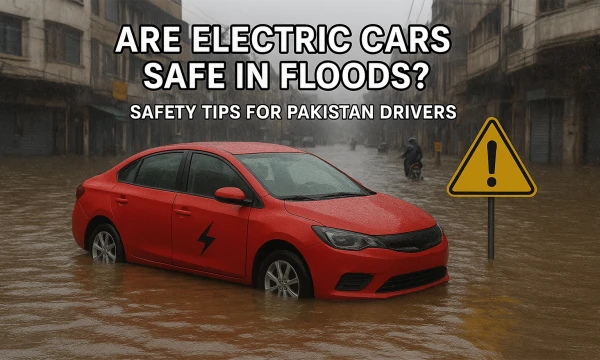
- Admin
- Sep 02, 2025
- Safety and Technology
Are Electric Cars Safe in Floods? | EV Safety Tips for Pakistan Drivers 2025
Pakistan is facing one of its worst flood emergencies in recent memory. With intense monsoon rains, widespread evacuations, and overflowing rivers, the stakes have never been higher—especially for electric vehicle (EV) owners.
The Flood Reality in Pakistan (2025)
-
In Punjab, severe floods have forced over one million people to evacuate, impacting 1,400+ villages and causing widespread infrastructure collapse.
-
At least 800 people have lost their lives in monsoon-related disasters since late June, with many more injured and 1.2 million people displaced.
-
In Punjab alone, flooding of the Ravi, Sutlej, and Chenab rivers submerged entire communities, disrupted grain production, and severely threatened food security.
-
Northern regions like Khyber Pakhtunkhwa were also hit hard by flash floods and landslides, especially in districts like Buner, Swat, and Bajaur, resulting in hundreds of fatalities and a tragic helicopter crash during rescue operations.
With such widespread devastation, the question isn’t just academic: Are electric cars safe in floods—or could they worsen the danger?
Are Electric Cars in Floods?
The answer is yes, with caution. Modern EVs are designed with strong safety features. These include:
-
Waterproof battery packs housed in sealed enclosures
-
Insulated high-voltage wiring and safety systems that disconnect power if water intrusion is detected
However, during extremely high floods like those caused by Pakistan’s current monsoon crisis; even the best engineering can be tested.
Risks for EVs Amid Widespread Flooding
-
Prolonged water exposure can compromise battery integrity and electrical systems, leading to malfunctions or loss of power.
-
Corrosion risks in floodwaters, especially those contaminated with sewage or debris, could degrade connections over time.
-
Costly repairs: Damage to EV systems is often more expensive to fix than conventional vehicles.
Electric Car Flood Safety Tips for Pakistani Drivers
Given the current crisis, here are essential safety measures to reduce risks to both you and your electric vehicle:
-
Avoid floodwater driving at all costs: With floodwaters above knee level sweeping through villages and towns, even conventional vehicles risk hydro-lock or stalling. EVs aren’t invincible.
-
Park on higher ground well in advance: When floods like this are predicted, prevent damage by relocating to elevated areas.
-
Watch for warning indicators: If your EV stalls or you notice battery error alerts, do not restart it. Wait for professional assistance.
-
Get a professional post-flood inspection: Only certified technicians should assess your EV after flood exposure. They can determine water intrusion, potential damage, and readiness for safe use.
-
Prioritize safety over convenience: Even if your EV seems to function normally, hidden damage can appear later. Stay vigilant.
EV Safety vs. Conventional Cars During Floods
| Vehicle Type | Floodstream Risk Level | Key Concern |
| Petrol/Diesel Cars | High | Hydrolock, engine damage |
| Electric Vehicles | Moderate | Electrical shorts, battery damage |
Both types of vehicles are vulnerable. However, EVs offer inherent electrical safety features but demand cautious handling after exposure to flood conditions.
Final Thoughts
With monsoon floods wreaking havoc across Pakistan in 2025, displacing communities, crippling infrastructure, and overwhelming emergency services. Vehicle safety has become critical. While electric cars in floods have advanced safety design, severe conditions can still pose serious risks.
If you own or plan to buy an EV, prioritize flood awareness, safe parking, and expert inspections. In times like these, the smartest decision is one made ahead of the crisis, not after it hits.
Stay safe, stay informed, and look out for one another.


Comments